Solving mycotoxins-related problems in dairy

In order to evaluate the impact of mycotoxins on performance and health of the animals, feeding trials under realistic conditions have to be carried out. Field studies reflect the real situation and provide reliable results related to the practice. These studies use natural contaminated feed which usually contains a mixture of mycotoxins (synergistic effects). In contrast, research studies perform trials with “pure” mycotoxins. Moreover, the trial period is often longer than in scientific trials, which is very important since most of the symptoms occur after weeks of exposure to the contaminated diets.
The following trial was carried after the acknowledgment of decreased productivity and poor health status in a dairy farm located in Côtes d’Armor, France. The problems registered in the herd included lowered feed intake, high incidence of diarrhea in calves, poor body condition scoring, poor fertility and high abortion rate, high mastitis incidence, high somatic cell count (SCC) in the bulk milk and reduced milk production. The feed was analyzed for mycotoxins by a certified laboratory so a correct diagnosis and treatment of the problem could be made.
A mycotoxin deactivator – Mycofix® Plus – was added to the feed after the analysis recognized mycotoxin’s contamination in the ration as can be seen in table 1. Performance and health parameters were followed after the inclusion of the product so its effects could be measured.
Table 1 - Results of mycotoxin analysis 
Trial Design:
This trial has been performed in a dairy herd with 50 Holstein cows with an average production of 9000Kg milk/animal/year. The cows were being fed a Total Mixed Ration (TMR) with 50% of maize.
According to the results of the mycotoxin analysis of the feed a treatment with 25g/cow/day of Mycofix® Plus was started on the 1st of May 2006, for the overall herd.
Results:
The results achieved with the inclusion of Mycofix® Plus in the feed were compared to the results on the previous months for the same herd (off-on trial design). Several parameters were measured, namely:
- Mastitis incidence (Figure 1);
- Somatic Cell Count (SCC) in bulk milk (Figure 2);
- Feed intake (Table 2);
- Cow fertility (Tables 3 and 4).
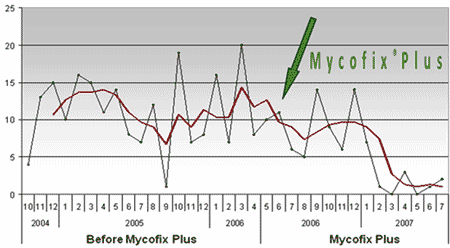
Figure 1 - Incidence of mastitis registered per month: Black line – total number of mastitis; Red line – average 4 months (OBS: not all the cases of mastitis were registered and therefore they are not included on the chart, especially in periods with high incidence of the problem, namely the first quarter of 2006).
Mastitis incidence before the trial affected 20 animals in some months prior to the use of the mycotoxin deactivator. With the beginning of the treatment in May 2006 the incidence of mastitis was immediately reduced. 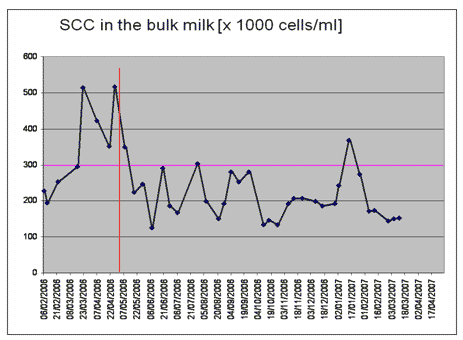
Figure 2 - Somatic cell count in bulk milk (OBS: on the control period (before MPL use), milk with too high SCC was discarded, thus reducing the disparity of the chart).
The SCC prior to the treatment was very high, reflecting a high incidence of mastitis problems in the cows. With the inclusion of Mycofix® Plus in the feed a reduction of this parameter was observed. The peak that can be found in January 2007 was due to a problem in by-pass nitrogen in the feed.
Table 2 - Feed Intake
The reduced feed intake prior to the treatment was improved throughout the trial, achieving a level of 23.7Kg of daily ingested feed per cow in January 2007.
Table 3 - Fertility Parameters (number of artificial inseminations (AI))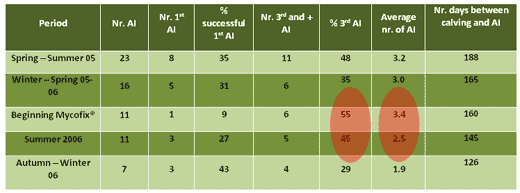
The average number of AI was lowered from 3.4 to 1.9 by using the mycotoxin deactivator. The low conception rates before the treatment can be deduced by the high percentage of 3rd artificial inseminations.
The percentage of successful first inseminations improved from 9% previous to the treatment to 43% in Autumn-Winter 2006, which clearly shows the improvement of the fertility rate. Parallel to this progress also the number of cysts was decreased and the heats were described as more regular.
The rate of non-conception was also increased from 29 to 49%, reflecting a higher success of the inseminations, thus a higher conception rate (information not displayed on the table).
Economic Calculations:
Table 4 - Treatment Costs
Before the use of Mycofix® Plus in this dairy herd, the treatment costs totalized 3 605€, from which the major expenses derived from mastitis and antibiotic treatments. A total of 1 892.79€ could be saved after the inclusion of the mycotoxin deactivator, due to the reduction of these costs. 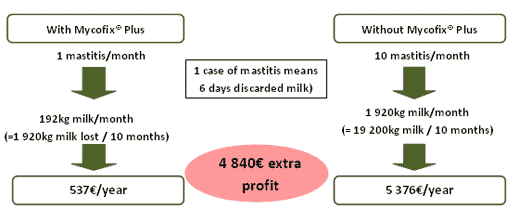
Figure 3 – Annual milk losses due to mastitis
The scheme in figure 3 shows the profit that is lost due to discarded milk originating from cows with mastitis and an excessively high SCC. One case of mastitis represents 6 days of discarded milk. Without mycotoxin treatment this farm was losing 5 376€/year due to the occurrence of, in average, 10 mastitis per month. When the mycotoxin deactivator is included in the diet, 4 840€ will be added to the profit once there is a substantial reduction in the mastitis incidence and therefore a considerable decrease of the discarded milk.
Table 5 - Economic calculations 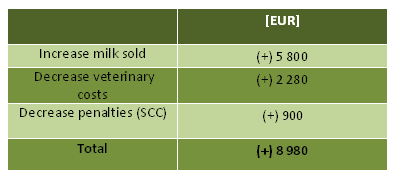
Table 5 clearly shows that the investment made on approximately 500Kg of Mycofix® Plus per year generates a profit of almost 9 000€.
Conclusion:
As it can be seen from the results shown above, the inclusion of a mycotoxin deactivator in this dairy farm which presented problems with mycotoxin contamination in feed, led to the improvement of health, reproductive and performance parameters. The treatment with 25g/cow/day of Mycofix ® Plus was able to counteract the negative effects of a feed contamination with 1025ppb trichothecenes and 120ppb zearalenone. Parameters such as mastitis incidence, somatic cell count of the milk, feed intake, fertility rate and treatment costs were improved, thus showing the successful results of Mycofix® Plus utilization.
Finally, by the analysis of the economic parameters, it can be easily assessed that the annual investment on a successful mycotoxin deactivator such as Mycofix® Plus will generate profits that will definitely overcome the expenses.
Author: DI Inês Rodrigues, Product Manager Mycofix® Product Line BIOMIN GmbH, Industriestrasse 21, 3130 Herzogenburg, Austria







.jpg&w=3840&q=75)